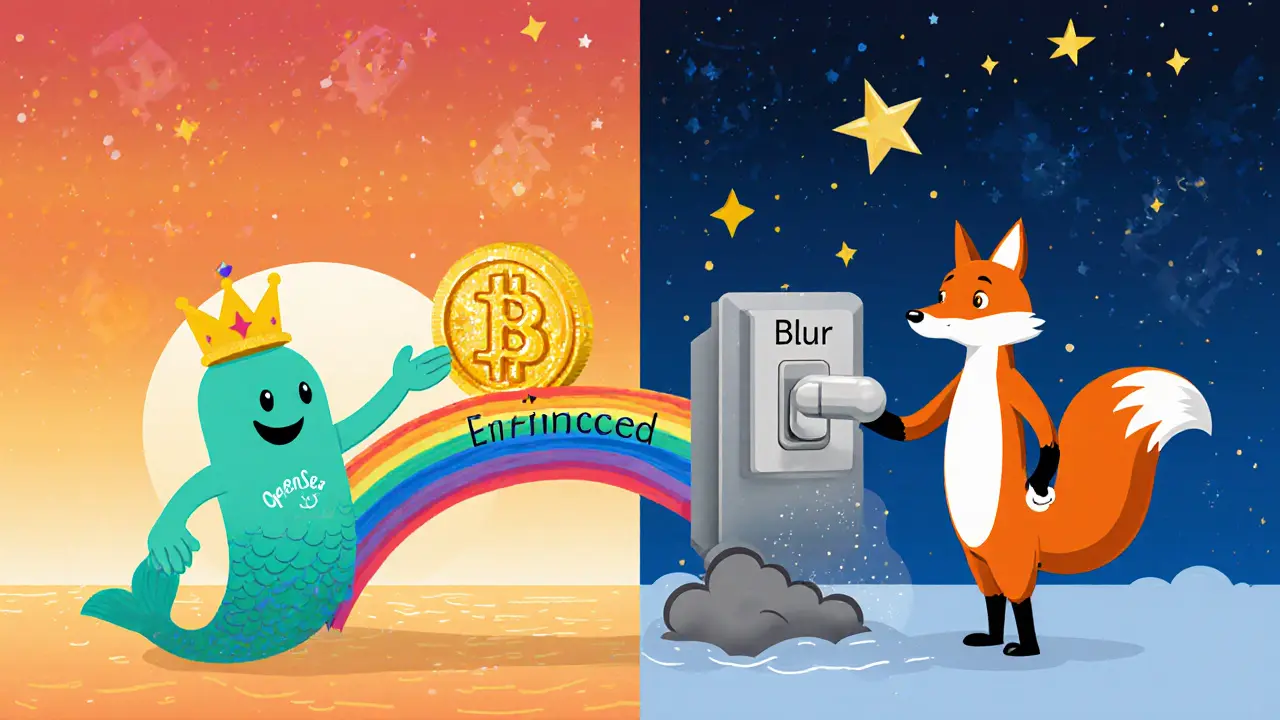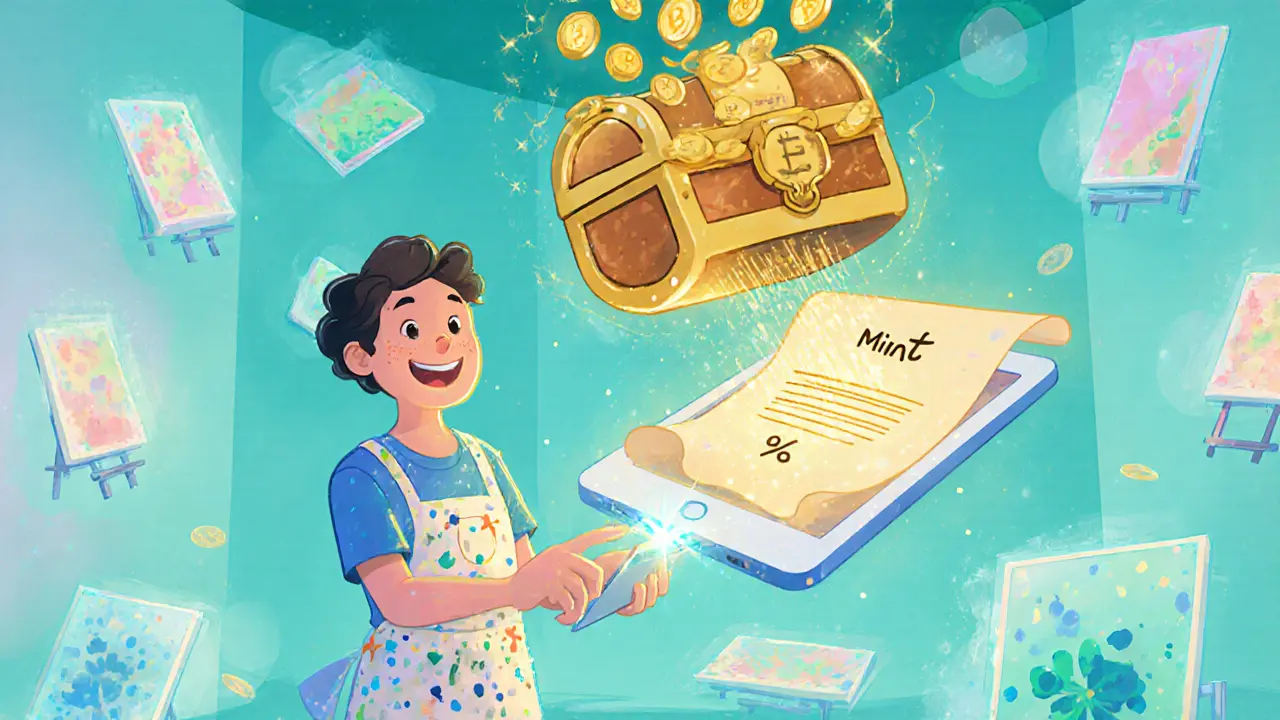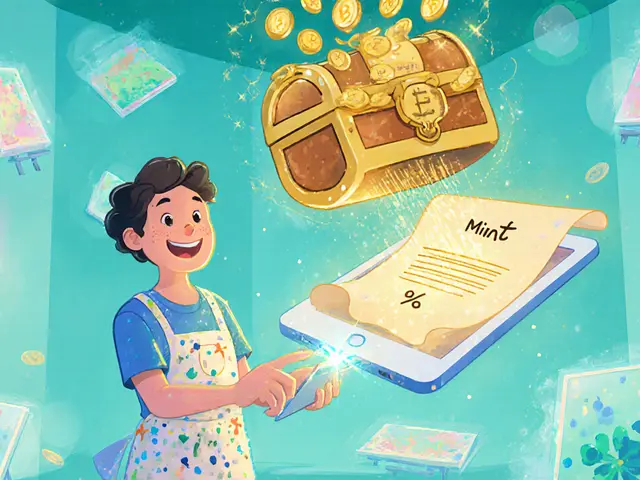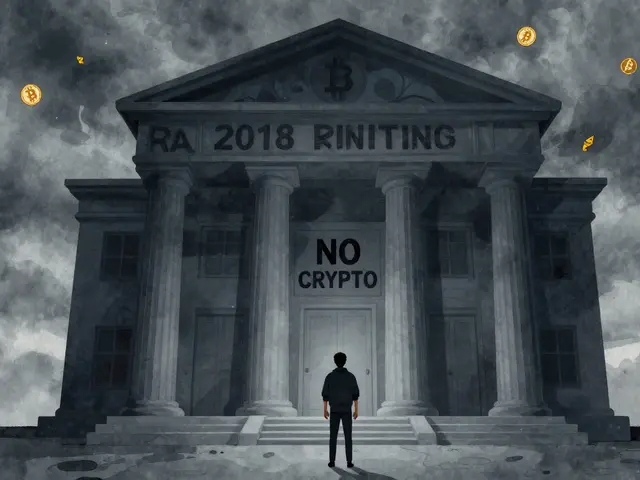NFT Royalty Calculator
Calculate how much you could earn in royalties from future NFT sales. Enter the sale price and your royalty percentage to see the potential earnings.
Royalty Calculation Result
Based on a sale price of and a royalty rate of , your potential royalty earnings would be .
Imagine you could sell a digital artwork once, then sit back while every future resale automatically sends you a slice of the profit. That’s the promise of NFT royalties - a blockchain‑driven payment stream that lets creators earn forever from a single mint.
What an NFT Royalty Actually Is
At its core, an NFT is a non‑fungible token that represents a unique piece of digital content on a blockchain. When you mint an NFT, you embed a smart contract self‑executing code that lives on the blockchain and enforces rules without a middleman. One of those rules can be a royalty clause: a percentage of any future sale that gets routed straight to the creator’s digital wallet a cryptographic address that holds cryptocurrencies and token assets.
How Royalties Are Set Up
Most creators never touch code. Platforms like OpenSea, Foundation, or SuperRare give you a simple slider during minting. You pick a percentage-usually between 2.5% and 15%-and the platform writes that into the token’s contract. The industry average sits around 5‑6%.
- Connect your wallet (MetaMask, Coinbase Wallet, etc.).
- Upload the file you want to tokenize.
- Enter the royalty percentage and the payout address.
- Pay the gas fee (roughly $50‑$200 on Ethereum as of 2024)
- Press “Mint”. The NFT and its royalty rules are now immutable.
Why Royalties Beat Traditional Licensing
Traditional royalties rely on contracts, collection agencies, and spreadsheets. You might wait months, even years, before a payment shows up. With NFTs, every resale triggers an instant, transparent transfer that’s recorded on the blockchain ledger. No paperwork, no middlemen.
- Automation - The smart contract handles the math and the payout.
- Transparency - Every transaction is public, so you can verify you received what you’re owed.
- Global reach - Anyone with a crypto wallet can buy, sell, or trade, regardless of country.
Enforcement Gaps: Not All Marketplaces Play Nice
Royalties only work when the marketplace respects the royalty field. Some platforms, like OpenSea, enforce creator earnings by default. Others-Blur, LooksRare-let sellers turn royalties off to boost profit margins. That shift dropped compliance from about 95% in early 2022 to roughly 60% by late 2023.
Because the royalty rule lives inside the token contract, a platform can technically ignore it, but the buyer would then be purchasing a token that “doesn’t pay” the creator. Collectors who value artist support tend to stick with royalty‑friendly sites, while high‑frequency traders gravitate toward the optional‑royalty venues.

Comparing the Top NFT Marketplaces
| Marketplace | Royalty enforcement | Typical creator earnings fee | Average gas‑free mint support |
|---|---|---|---|
| OpenSea | Enforced (creator earnings) | 2.5% - 10% (set by creator) | Yes (Polygon layer‑2) |
| Foundation | Enforced | 5% - 15% (creator choice) | No (Ethereum mainnet) |
| Blur | Optional (can be turned off) | 0% - 2.5% (platform fee only) | No |
| LooksRare | Optional | 0% - 2% (platform fee) | No |
Best Practices for Setting a Sustainable Royalty Rate
Finding the sweet spot matters. Too high, and collectors balk; too low, and you leave money on the table. Here’s a quick cheat sheet:
- Start at 5% if you’re a newer creator. It’s low enough to encourage trading but still gives you a foothold.
- Raise to 10‑12% for limited‑edition drops where scarcity drives higher resale prices.
- Consider split royalties if you collaborated-many platforms let you allocate percentages to multiple wallets.
- Watch the secondary market for your collection. If trade volume spikes, you might lower the rate to keep buyers happy.
Tax and Legal Touch‑Points
Every royalty payout is a taxable event in most jurisdictions, including Australia. Treat them as ordinary income and keep a spreadsheet of dates, amounts, and wallet addresses. If you’re selling high‑value NFTs, consult a tax professional-crypto tax rules can get tricky fast.
Future Trends Shaping NFT Royalties
The space is still evolving. A few developments to watch:
- EIP‑2981 upgrades-the Ethereum Improvement Proposal aims to make royalty data universally readable across all marketplaces.
- Time‑decay royalties-the percentage drops after a set period, rewarding early collectors while still giving creators a tail wind.
- Utility‑based royalties-instead of resale price, the royalty ties to how often an NFT is used in a game or metaverse.
- Regulatory moves-the EU’s MiCA framework may mandate royalty compliance for platforms operating in Europe by 2025.

Getting Started: A Mini‑Checklist
- Choose a blockchain (Ethereum, Polygon, Solana) that matches your audience’s wallet habits.
- Set up a secure wallet and back up the seed phrase.
- Select a royalty‑friendly marketplace.
- Decide on a royalty percentage based on your brand and market norms.
- Mint your NFT, double‑check the royalty field, and confirm the transaction.
- Promote the drop and monitor secondary‑sale activity.
- Keep records for tax reporting and adjust royalty rates as needed.
Common Pitfalls and How to Avoid Them
Pitfall: Setting a 15% royalty and watching sales stall. Fix: Start lower, gauge collector appetite, then tweak on future drops.
Pitfall: Minting on a high‑fee network and blowing your budget. Fix: Use layer‑2 solutions like Polygon for cheaper gas.
Pitfall: Ignoring royalty enforcement differences and losing income. Fix: Track where your NFTs are listed and favor platforms that honor creator earnings.
Real‑World Example: From Mint to Ongoing Income
Jane, an indie musician from Melbourne, minted a limited‑edition album cover NFT on OpenSea with a 7% royalty. She sold the first copy for AU$1,200. Six months later, a collector resold it for AU$5,000 on the same platform. Jane automatically received AU$350 (7% of AU$5,000) without lifting a finger. The transparent blockchain record also let her prove ownership to future collaborators, opening doors for sync licensing deals that wouldn’t have existed with a static JPEG file.
Wrapping Up the Journey
NFT royalties turn a one‑off sale into a living revenue stream. They give creators control, transparency, and global reach that traditional licensing struggles to match. The system isn’t perfect-royalty enforcement can be patchy, and tax obligations add a layer of complexity-but with the right marketplace, a sensible royalty rate, and a dash of patience, you can start earning passive income from your digital work today.
Frequently Asked Questions
Do I need to know how to code to set NFT royalties?
No. Most major marketplaces provide a simple slider or input field during minting. You just choose the percentage and the wallet address that should receive the payments.
Can collectors avoid paying royalties?
They can on platforms that make royalties optional, like Blur. However, the token’s smart contract still records the royalty term; it’s just not enforced by the marketplace.
How are royalty payments taxed?
In most countries, each royalty receipt is treated as ordinary income. Keep a ledger of dates, amounts, and wallet IDs, and report them on your tax return. Consulting a tax professional is advisable for larger sums.
What happens if the royalty percentage is set too high?
Collectors may shy away, lowering secondary‑sale volume. A common strategy is to start at 5% and adjust upward for future drops once you gauge market appetite.
Are there any upcoming standards that will improve royalty enforcement?
Yes. The Ethereum community is working on EIP‑2981 enhancements to make royalty data readable on any platform. Additionally, proposed EU MiCA regulations may legally require platforms to honor royalty terms by 2025.







Prabhleen Bhatti
October 10, 2025 AT 03:21NFT royalties are the closest thing we’ve ever had to digital feudalism-except the serfs get paid every time their lord resells the land! 🤯 The smart contract is basically a digital notary that never sleeps, never takes a break, and never forgets your 7% cut. It’s wild how blockchain turns art into a perpetually yielding asset-like planting a tree that grows money every time someone chops a branch off.
But let’s be real: if you’re minting on Blur, you’re basically handing your future income to the wolves. I’ve seen collectors brag about ‘avoiding royalties’ like it’s some kind of hack. Bro, you’re not a pirate-you’re just bad at math and worse at ethics.
And don’t even get me started on tax implications. Every time you get paid, it’s a taxable event-no grace period, no ‘oops, I forgot’. Australia’s ATO is already tracking wallet addresses like they’re GPS trackers. If you’re not keeping a spreadsheet, you’re already in trouble.
Also-EIP-2981? YES. If we can standardize royalty metadata across chains, we might finally stop this marketplace arms race where platforms compete to be the most exploitative. Imagine if every NFT carried its own royalty DNA-immutable, readable, enforceable-no matter where it went. That’s the dream.
And creators? Start at 5%. Seriously. I’ve seen 15% NFTs gather dust while 5% ones sell out in minutes. It’s not greed-it’s liquidity. People want to trade, not hoard. You want royalties? Make it easy to resell. That’s the real win.
Elizabeth Mitchell
October 10, 2025 AT 05:39Interesting read. I’ve never minted anything, but I’ve bought a few NFTs just because I liked the art. Didn’t even think about royalties until now. Kinda makes me feel like I’m supporting someone instead of just collecting pixels.
Chris Houser
October 10, 2025 AT 09:50Let me break this down simple: NFT royalty = creator gets paid every time their work changes hands. That’s it. No lawyers. No middlemen. No waiting 18 months for a check. If you’re a digital artist, this is your first real shot at sustainable income. Stop overcomplicating it. Pick a platform that pays you. Set 5%. Mint. Walk away. Let the blockchain do the work.
And if you’re a collector? If you care about artists, don’t buy on Blur. Vote with your wallet. Simple as that.
William Burns
October 10, 2025 AT 11:30While the concept of algorithmic remuneration via immutable smart contracts is theoretically elegant, one must interrogate the epistemological underpinnings of such a system. The very notion of ‘ownership’ in a decentralized, permissionless ledger system is a semantic oxymoron-ownership implies stewardship, and stewardship implies accountability, which blockchain, by design, deliberately obviates. Furthermore, the imposition of royalty mechanisms through non-standardized, platform-dependent implementations constitutes a form of techno-feudal coercion, wherein creators are coerced into participating in a speculative economy they neither fully understand nor control. The tax implications alone render this model unsustainable for any but the most financially sophisticated actors.
Ashley Cecil
October 11, 2025 AT 09:11It’s appalling how casually people treat blockchain royalties as some kind of passive income miracle. Every royalty payment is taxable income-period. And yet, 90% of creators don’t even know they need to report it. This isn’t ‘free money’-it’s unregulated, volatile, and legally precarious. If you’re going to mint an NFT, you’re entering a complex financial ecosystem with international tax obligations, anti-money laundering compliance, and potential capital gains exposure. This isn’t a hobby. It’s a business. And if you’re not treating it like one, you’re setting yourself up for an audit nightmare.
John E Owren
October 11, 2025 AT 10:52Everyone’s talking about royalties like it’s magic, but no one’s talking about the fact that most NFTs are worthless after the first sale. The system rewards the early adopters and punishes the latecomers. If you’re a creator, your 5% on a $5,000 resale sounds great-but what if your NFT only sells once? Then your royalty is $0. And what if the buyer flips it on Blur? Then your royalty is $0 again. The system only works if the market keeps moving-and right now, it’s a sinking ship with a few lucky liferafts.
Also, gas fees are still a joke. $150 to mint a 10% royalty on a JPEG that might sell for $200? That’s not empowerment. That’s a tax on creativity.
Joseph Eckelkamp
October 11, 2025 AT 14:49Oh wow, look who finally figured out that blockchain can automate payments. 🙃 The 2017 version of this was ‘Bitcoin will replace banks!’ and now we’re at ‘NFTs will replace record labels!’-and yet, here we are, still using PayPal for merch sales. The irony is thick enough to spread on toast.
Let’s be honest: if your art needs a 7% royalty to be valuable, maybe it’s not worth owning in the first place. But hey, if you wanna sell a JPEG and call it ‘digital heritage’ while pretending you’re Van Gogh, go ahead. I’ll be over here, buying physical paintings with actual brushstrokes and zero gas fees.
Also, EIP-2981? Cute. But until every exchange, wallet, and marketplace actually implements it, it’s just a wishlist item with a fancy acronym.
Jennifer Rosada
October 12, 2025 AT 10:10It’s irresponsible to present NFT royalties as a ‘solution’ without addressing the environmental cost of Ethereum’s proof-of-work legacy-even though it’s moved to PoS, the damage to public perception remains. And let’s not pretend this isn’t a speculative bubble wrapped in a moral justification. ‘Support the artist’? Sure. But when 99% of NFTs are bought by bots and flipped within minutes, who’s really being supported? The artist? Or the whale who bought the first one and is now cashing out?
Also, ‘royalty-friendly’ platforms are just marketing terms. The truth? Most collectors don’t care. They just want the cheapest, fastest flip. And if that means ignoring royalties, they’ll do it. This isn’t a revolution-it’s a loophole.
adam pop
October 12, 2025 AT 12:41Big Tech is using NFTs to track your every move. That ‘wallet address’? It’s your new social security number. Every resale is logged. Every transaction is monitored. The government already knows how much you made. The banks are watching. The AI is learning your habits. This isn’t freedom-it’s surveillance capitalism with blockchain glitter on it. They want you to think you’re in control. You’re not. You’re just another data point in a ledger that doesn’t care who you are.
Dimitri Breiner
October 12, 2025 AT 18:17Look, the royalty system isn’t perfect-but it’s the best thing that’s happened to digital creators since the internet. If you’re a musician, illustrator, or writer, this is your chance to get paid every time your work circulates. No more begging for licensing deals. No more waiting for a check that never comes. Just mint it, set 5%, and let the blockchain do the rest.
And if you’re a collector? If you want to support real creators, don’t buy on platforms that let people disable royalties. That’s not a feature-it’s a betrayal. Your wallet is your voice. Use it wisely.
Also, use Polygon. Gas fees on Ethereum are criminal for small creators. Don’t let cost kill your dream.
LeAnn Dolly-Powell
October 13, 2025 AT 10:41This made me cry a little 😭 I’m a mom who draws cartoons for my kids, and I just minted my first NFT with a 6% royalty. I didn’t think anyone would buy it… but someone did! And then someone else resold it and I got $42. I didn’t even have to do anything. I just… sat there. And got paid. For something I made for fun. I’m not rich. But I feel seen. Thank you for writing this. 💖
Anastasia Alamanou
October 13, 2025 AT 14:50One thing missing from most discussions: the power of split royalties. If you collaborated with a writer, animator, or sound designer, you can allocate percentages to multiple wallets. That’s huge. It turns creative collaboration into a transparent, automated partnership. No more ‘I’ll pay you later’-the contract pays everyone at once, on-chain, instantly. This isn’t just about money-it’s about recognizing collective labor in a way traditional contracts never could.
And yes, start at 5%. But don’t be afraid to adjust. Watch your secondary market. If your NFTs are flipping like crazy, lower the royalty to keep the ecosystem alive. Sustainability > greed.
Also-use OpenSea on Polygon. Always. Gas fees are $0.02. You can mint 100 NFTs for less than a coffee. Why wouldn’t you?
Rohit Sreenath
October 14, 2025 AT 07:27You think you’re smart because you minted an NFT? Everyone is doing it. The real artists are painting in silence, not chasing crypto. Royalties? That’s just another way to sell your soul for a few dollars. The blockchain doesn’t care about your art. It only cares about transactions. You’re not a creator-you’re a data node.